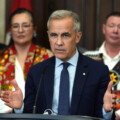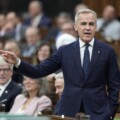A few weeks ago, I asked Conservative Party leader Pierre Poilievre why he thought the Trudeau government had opened up immigration so dramatically in the aftermath of the pandemic. His best hypothesis was that the government was responding to businesses who wanted to drive up labour competition and drive down wages. It’s a classic public choice story.
Poilievre’s answer brought me back to one of Canada’s most important political economy books in recent decades, Brian Lee Crowley’s 2009 book, Fearful Symmetry: The Fall and Rise of Canada’s Founding Values. (Full transparency: I was Crowley’s research assistant for the book.)
His audacious thesis was that the previous four or five decades of Canadian policy and politics were best understood through the interaction between the rise of Quebec nationalism and the demographic dominance of the Baby Boom generation. The book then speculated on what might happen as these key cultural and demographic forces fell into secular decline.
From a labour market point of view, Crowley’s key insight was that Canada’s Baby Boom—one of the largest in the industrialized world—created a structural imbalance between labour supply and demand for the better part of four decades. The consequence was to strengthen the relative bargaining power of employers, put downward pressure on wages, and raise the floor of unemployment.
One may not have liked these outcomes, but the supply-demand gap behind them was natural. It wasn’t the consequence of nefarious businesses or distortionary policies. Government policy, in fact, as Crowley set out, was consumed (perhaps too much) by managing the effects of a labour market equilibrium rooted in fertility rates that produced a lot of joblessness.
The aging of the Baby Boomers, including their withdrawal from the workforce, comes with pluses and minuses. It’s well documented, for instance, that it will put significant pressure on government budgets as the inexorable demand for public pensions and health care rises. On the other hand, one of the anticipated upsides is that it should reset the structural imbalance at the heart of Canada’s labour market. If natural labour market growth was behind it, then, ostensibly, its demographic inversion would reverse it.
The effect would be for the asymmetry between businesses and workers to tilt in favour of the latter, who would now have more employment options and, in turn, could demand higher wages and other benefits. It would also shift the incentives for businesses to invest more in capital, especially labour-substituting technologies, which could boost Canadian productivity.
Crowley anticipated that these trends would have major and mostly positive consequences on Canadian policy and politics. In particular, he envisioned a positive-sum future where work and its material and non-material benefits would be essentially available to anyone who wanted them.
But that’s not quite what’s happened. The past few years have challenged Crowley’s thesis precisely because of Poilievre’s point. Business and government have essentially conspired to undo the natural trend towards a more pro-worker environment by flooding the labour market with unprecedented increases in immigration, particularly non-permanent resident and low-skilled immigration.

Prime Minister Justin Trudeau poses with new Canadians as he attends a citizenship ceremony at Acadia University in Wolfville, N.S. on Tuesday, March 3, 2020. Andrew Vaughan/The Canadian Press.
And so, after waiting for decades for more favourable labour market conditions, workers are watching those conditions be undermined by government policy. The promise of better jobs and higher wages is being taken from them.
There’s a tendency to think about corporate welfare as cash subsidies or targeted tax breaks. But we should understand that Trudeau-era immigration policy is a kind of corporate welfarism, too. It’s an intervention into natural market dynamics that privileges the interests of businesses over workers. And it’s on a scale that’s far greater and more durable than the billions for aerospace or auto companies.
This massive influx of workers was done under the auspices of labour shortages. One can sympathize with workers who find the whole notion a bit rich. It’s really employers saying that they cannot find workers at the wages they want to pay, which is close to the equivalent of consumers saying that there’s an iPhone shortage because they cost $500 even though we’d prefer to pay $200. That’s not a shortage. That’s the market telling us the prevailing price.
Now, it must be said that Crowley was by no means naïve about these risks. His book literally coined the phrase “PUPPETRY”—People Using Political Power to Enrich Themselves by plundeRing You—to capture the essence of the public choice problem. He deeply understood that government policy can be manipulated by narrow interests for whom politicians are inclined to be responsive. But I suspect even he would be surprised by the brazenness of Trudeau-era immigration policy to structurally reverse the natural trend towards a pro-worker labour market.
That so many unions supported (and continue to support) the Liberals in spite of the harmful effects their immigration policy has had on workers is a sign that the core interests of their dues-paying members are secondary to standard-fare left-wing politics. The message is clear: Progressive politicians can get away with neglecting or even hurting the interests of workers as long as they reliably nod to identity politics or anti-Zionism or whatever motivates union activists.
Poilievre and the Conservatives are right to call this out. What’s happening reflects a “markets for me, but not for thee” on the part of a lot of businesses and a responsiveness on the part of the Liberals that’s neither pro-market nor pro-worker. It’s an indirect subsidy to corporations.
A real commitment to the interests of workers wouldn’t involve left-wing government intervention. It’s a laissez-faire approach that would enable market forces to manage the relationship between supply and demand and set wages accordingly. It would mean allowing the post-Baby Boom labour squeeze to increase wages and encourage productivity-enhancing investment rather than racing to import cheaper labour.
Government can and should, of course, support disabled workers with wage subsidies or other forms of employment assistance. It should also help unemployed workers through social insurance. But it shouldn’t be actively tipping the scale between businesses and workers by micromanaging the labour market itself. The harms of the Trudeau government’s anti-worker immigration policy are now evident in the country’s high youth unemployment and growing public skepticism for immigration itself.
The government must stop distorting the labour market and allow the structural forces that Crowley anticipated to play out. The retirement of the Baby Boom generation presents a once-in-a-generation opportunity to reset the balance of power in favour of workers, encourage long-overdue capital investment, and raise productivity across the economy. These are not zero-sum outcomes—they’re the building blocks of a healthier, more dynamic, and more inclusive economic future. But they can only emerge if we have an immigration policy rooted in the country’s interests rather than business interests.
Canada doesn’t need more PUPPETRY. It needs a renewed commitment to the positive-sum future that Crowley envisioned.










